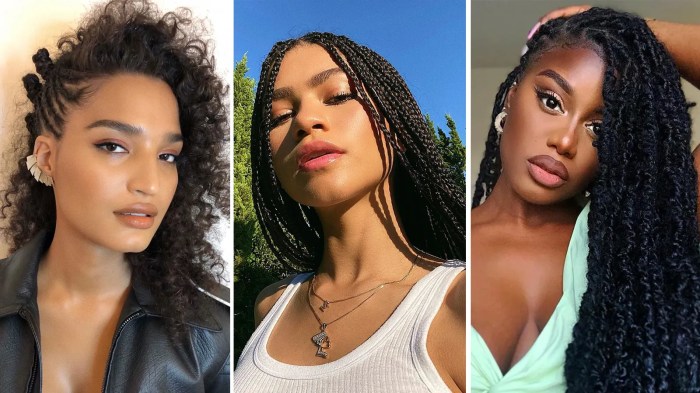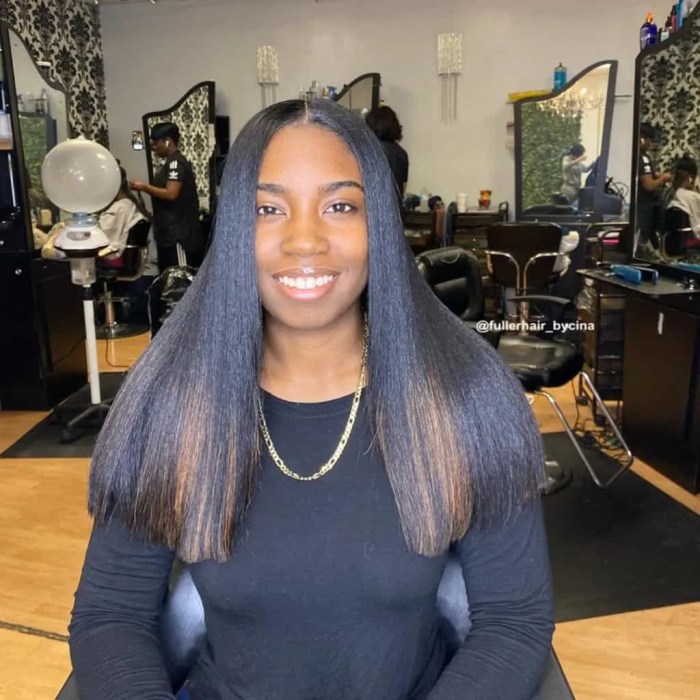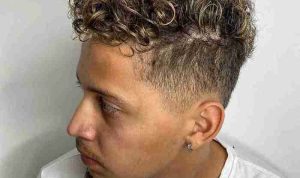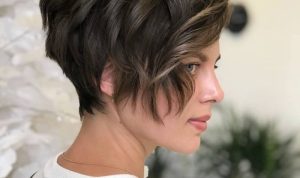Popular Natural Black Hairstyles
Hairstyles for natural black hair – Natural black hair offers a stunning array of styling possibilities. Understanding different hairstyles, their suitability, and maintenance needs is crucial for achieving a look that’s both stylish and healthy. This section explores ten popular natural black hairstyles categorized by length, providing insights into their best face shapes and maintenance levels.
Popular Natural Black Hairstyles by Length
| Hairstyle Name | Description | Best Face Shape | Maintenance Level |
|---|---|---|---|
| Short Tapered Cut | Closely cropped on the sides and back, with slightly longer hair on top. | Oval, Round | Low |
| Short Afro | A voluminous, naturally curly style that’s close to the scalp. | Oval, Heart | Medium |
| Medium-Length Twist-Outs | Two-strand twists that are unraveled to create loose, defined curls. | Oval, Square | Medium |
| Medium-Length Bantu Knots | Sections of hair twisted into knots, creating a textured and voluminous style. | Oval, Round | Medium |
| Medium-Length Wash and Go | A simple style that involves washing and conditioning the hair, then letting it air dry naturally. | Most face shapes | Low |
| Long Box Braids | Individual braids that are neatly sectioned and extended to various lengths. | Most face shapes | Low to Medium |
| Long Cornrows | Closely braided styles that lie flat against the scalp. | Most face shapes | Low to Medium |
| Long Crochet Braids | Braids created by crocheting synthetic hair onto natural braids. | Most face shapes | Low |
| Long Twist Braids | Two-strand twists that are extended with added hair. | Most face shapes | Low to Medium |
| Long Afro | A voluminous, naturally curly style that extends past the shoulders. | Oval, Heart | High |
Styling Tips for Natural Black Hairstyles
Maintaining these styles requires consistent care. Here are five general styling tips applicable to most natural black hairstyles:
- Deep condition regularly: Deep conditioning treatments replenish moisture and strengthen hair, preventing breakage and dryness.
- Use a moisturizing leave-in conditioner: This adds extra hydration and helps to detangle hair.
- Protect your hair at night: Sleeping with a satin scarf or bonnet minimizes friction and prevents breakage.
- Limit heat styling: Excessive heat can damage hair, so air drying or using low heat settings is recommended.
- Trim split ends regularly: Regular trims prevent split ends from traveling up the hair shaft, causing further damage.
Cultural Significance of Selected Hairstyles
Certain natural black hairstyles hold deep cultural significance, reflecting history, identity, and tradition. Let’s examine three examples:
- Afro: The Afro, symbolizing Black pride and natural beauty, emerged as a powerful statement during the Black Power movement of the 1960s and 70s. It challenged Eurocentric beauty standards and celebrated the unique texture and volume of African hair. Its evolution continues today, with variations in size and style reflecting individual preferences and cultural expressions.
- Cornrows: Cornrows, a traditional style with origins in Africa, have been worn for centuries. Their intricate patterns often carry symbolic meanings and vary across different African cultures. The style’s adaptability and versatility have made it a staple in Black communities worldwide, evolving from functional protective styles to elaborate artistic expressions.
- Bantu Knots: Bantu knots, originating in Southern Africa, are a versatile style offering both protection and a fashionable look. Their history is rich with cultural significance, representing community, tradition, and personal style. Modern interpretations showcase diverse sizes, placements, and decorative elements, highlighting the enduring appeal of this classic style.
Protective Styling for Natural Black Hair
Protective styling techniques are crucial for maintaining the health and length of natural black hair. These styles shield the ends from environmental damage and reduce manipulation, promoting growth and minimizing breakage. This section explores two common protective styles and compares the benefits and drawbacks of several popular options.
Step-by-Step Guide: Box Braids
This guide details the creation of box braids, a popular protective style.
- Sectioning: Imagine dividing the hair into numerous square sections, creating a grid-like pattern across the scalp. Each section will form the base of a single braid.
- Braiding: Starting with one section, begin braiding by adding extensions (synthetic or natural hair) to the base. The braiding process involves tightly interweaving the natural hair with the extensions to create a neat, uniform braid.
- Securing: Once the braid reaches the desired length, secure the end using a small elastic band. Repeat this process for each section, ensuring consistent tension and neatness throughout.
Step-by-Step Guide: Two-Strand Twists
Two-strand twists offer a simpler, quicker protective styling option.
- Sectioning: Divide the hair into smaller sections, either uniformly or in a more free-flowing pattern. The size of the sections will determine the thickness of the twists.
- Twisting: Take a section and divide it into two equal parts. Twist each part in opposite directions, then twist the two parts together, continuously wrapping them around each other. Maintain consistent tension to prevent the twists from unraveling.
- Securing: Secure the end of each twist using a small elastic band or by tucking the ends underneath. The finished look is a series of neat, well-defined twists.
Comparison of Protective Styles

Source: glamour.com
Several protective styles offer various advantages and disadvantages. Here’s a comparison of three common options:
- Box Braids:
- Benefits: Low maintenance, long-lasting, promotes hair growth.
- Drawbacks: Can be time-consuming to install, potential for scalp irritation if too tight.
- Two-Strand Twists:
- Benefits: Relatively quick to install, less tension on the scalp compared to braids.
- Drawbacks: May not last as long as braids, requires more frequent re-twisting.
- Cornrows:
- Benefits: Long-lasting, versatile, protects hair well.
- Drawbacks: Can be time-consuming to install, potential for scalp irritation if too tight.
Hair Care During Protective Styling
Proper hair care is essential even during protective styling. Regular moisturizing and cleansing are vital to prevent dryness and scalp build-up.
- Moisturizing: Use a leave-in conditioner and hair oil to keep the hair and scalp hydrated.
- Cleansing: Use a gentle clarifying shampoo to remove product build-up and dirt, but avoid washing too frequently to prevent dryness.
Natural Hair Products and Ingredients
Choosing the right hair products is vital for maintaining healthy natural black hair. Understanding key ingredients and their benefits helps in making informed decisions. This section identifies key ingredients, provides product recommendations, and compares natural and chemically treated products.
Exploring hairstyles for natural black hair offers a wealth of options, from intricate braids to stylish afros. For men with naturally curly hair seeking a shorter style, consider checking out some inspiring looks at mens short hairstyles curly hair for ideas. This can help you find the perfect low-maintenance cut that complements your hair texture and personal style, ultimately informing your choices for longer natural black hairstyles.
Key Ingredients in Natural Hair Products
| Ingredient | Benefits |
|---|---|
| Shea Butter | Deeply moisturizes, protects from damage, reduces breakage. |
| Coconut Oil | Penetrates the hair shaft, adds shine, reduces protein loss. |
| Jojoba Oil | Mimics sebum, moisturizes without weighing hair down, soothes scalp. |
| Aloe Vera | Soothes scalp irritation, promotes hair growth, conditions hair. |
| Avocado Oil | Rich in vitamins and fatty acids, moisturizes, strengthens hair. |
Product Recommendations by Hair Type, Hairstyles for natural black hair
Product selection should consider individual hair type and needs. The following are general recommendations and may need adjustment based on specific hair characteristics.
- 4a: A moisturizing leave-in conditioner, a lightweight curl cream, and a light oil.
- 4b: A deep conditioner, a heavier curl cream or butter, and a sealant oil.
- 4c: A highly moisturizing deep conditioner, a thick leave-in conditioner, a rich butter, and a sealant oil.
Natural vs. Chemically Treated Hair Products
Natural hair products utilize plant-based ingredients, minimizing the risk of harsh chemicals. Chemically treated products often contain sulfates, silicones, and parabens, which can strip natural oils, cause build-up, and potentially damage hair over time. While chemically treated products might offer immediate results, long-term use can negatively impact hair health. Natural products prioritize gentle cleansing, deep hydration, and strengthening, promoting long-term hair health.
Styling Techniques for Different Hair Textures
Styling techniques should be tailored to hair texture and density for optimal results. This section demonstrates techniques for Type 4 hair, compares techniques for different densities, and emphasizes the importance of understanding hair porosity.
Styling Techniques for Type 4 Hair
Type 4 hair, characterized by its tightly coiled texture, requires gentle handling and moisturizing products. Here are three styling techniques suitable for this hair type:
- Shrinkage Control: This involves stretching the hair before styling to reduce shrinkage and reveal length. Techniques include banding, braiding, or using a blow dryer with a diffuser attachment. Products such as stretching creams or gels can aid in the process.
- Twist-Outs/Braid-Outs: These techniques involve twisting or braiding damp hair, allowing it to dry, then unraveling the twists or braids to reveal defined curls. A leave-in conditioner and a styling cream or gel are essential for moisture and definition.
- Protective Styling: This involves styles like braids, twists, or bantu knots, which minimize manipulation and protect the hair from environmental damage. These styles often require the use of hair extensions and should be installed by a professional for optimal results.
Comparison of Styling Techniques for Different Hair Densities
Hair density affects the choice of styling techniques. Here’s a comparison for different densities:
- Thin Hair: Avoid heavy products that can weigh hair down. Opt for lightweight styling creams, gels, and mousses. Avoid overly tight styles that can cause breakage.
- Medium Hair: Offers more styling versatility. A wider range of products and styles can be used, balancing volume and definition.
- Thick Hair: May require sectioning to manage the volume. Heavy-duty products can be used to control frizz and define curls. Protective styles can be beneficial to reduce daily manipulation.
Importance of Hair Porosity

Source: blackbeautybombshells.com
Hair porosity refers to the hair’s ability to absorb and retain moisture. Understanding your hair porosity guides product selection and styling techniques. Low porosity hair needs lightweight products and gentle manipulation to avoid product build-up. High porosity hair requires moisturizing products to seal in moisture and prevent dryness. Knowing your porosity helps optimize hydration and styling results.
Maintaining Healthy Natural Black Hair
Maintaining healthy natural black hair requires a consistent routine and attention to detail. This section Artikels a weekly hair care routine, addresses common hair problems, and emphasizes the importance of regular trims and deep conditioning.
Weekly Hair Care Routine
A consistent routine is key to healthy hair. Here’s a sample weekly plan:
- Sunday: Deep condition and moisturize.
- Monday-Saturday: Style hair as desired, focusing on gentle manipulation and protective styles.
- Wash Day (every 1-2 weeks): Cleanse hair with a gentle sulfate-free shampoo, follow with a moisturizing conditioner, and apply a leave-in conditioner and oil.
Common Hair Problems and Solutions
Several common issues affect natural black hair. Here are some solutions:
- Dryness: Deep condition regularly, use moisturizing products, and limit heat styling.
- Breakage: Handle hair gently, avoid tight styles, and trim split ends regularly.
- Dandruff: Use an anti-dandruff shampoo and conditioner, and consider using essential oils to soothe the scalp.
- Itching: Use gentle products, avoid harsh chemicals, and keep the scalp clean and moisturized.
- Product Build-Up: Use a clarifying shampoo occasionally to remove product build-up.
Importance of Regular Trims and Deep Conditioning
Regular trims remove split ends, preventing further damage and promoting healthy hair growth. Deep conditioning treatments replenish moisture, strengthen hair, and improve elasticity, contributing to overall hair health and shine. These practices are essential for maintaining healthy, vibrant natural black hair.
FAQ Corner: Hairstyles For Natural Black Hair
How often should I wash my natural black hair?
The frequency depends on your hair’s porosity and scalp type. Generally, washing every 1-2 weeks is recommended, but some may need to wash more or less frequently.
What is the best way to detangle natural black hair?
Always detangle in the shower with a conditioner to reduce breakage. Start from the ends and work your way up to the roots, using a wide-tooth comb or your fingers.
How can I prevent breakage in my natural black hair?
Minimize heat styling, use gentle detangling techniques, moisturize regularly, and trim split ends to prevent further damage.
What are some good leave-in conditioners for natural black hair?
Many excellent leave-in conditioners are available. Look for products containing moisturizing ingredients like shea butter, aloe vera, and glycerin. Consider your hair’s porosity when choosing a product.






